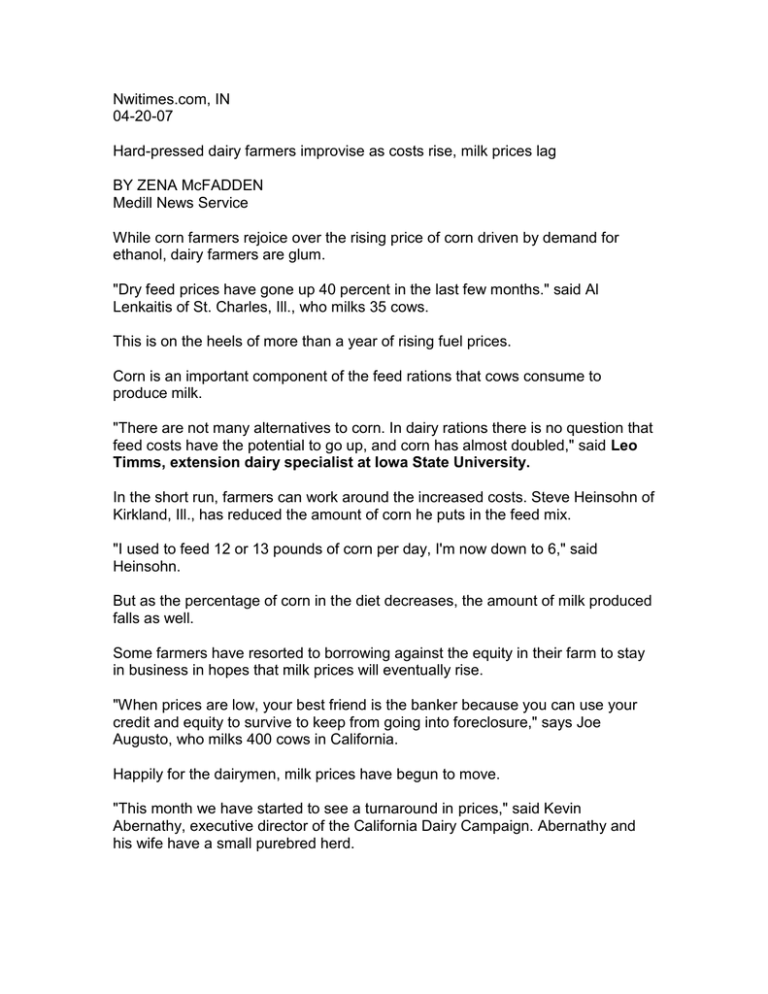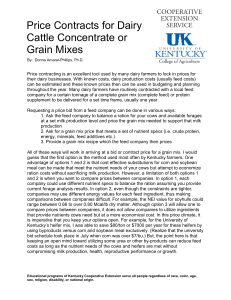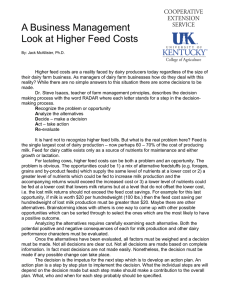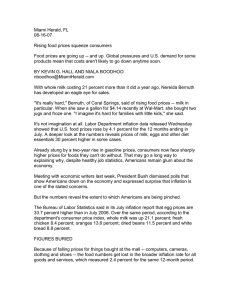Nwitimes.com, IN 04-20-07
advertisement

Nwitimes.com, IN 04-20-07 Hard-pressed dairy farmers improvise as costs rise, milk prices lag BY ZENA McFADDEN Medill News Service While corn farmers rejoice over the rising price of corn driven by demand for ethanol, dairy farmers are glum. "Dry feed prices have gone up 40 percent in the last few months." said Al Lenkaitis of St. Charles, Ill., who milks 35 cows. This is on the heels of more than a year of rising fuel prices. Corn is an important component of the feed rations that cows consume to produce milk. "There are not many alternatives to corn. In dairy rations there is no question that feed costs have the potential to go up, and corn has almost doubled," said Leo Timms, extension dairy specialist at Iowa State University. In the short run, farmers can work around the increased costs. Steve Heinsohn of Kirkland, Ill., has reduced the amount of corn he puts in the feed mix. "I used to feed 12 or 13 pounds of corn per day, I'm now down to 6," said Heinsohn. But as the percentage of corn in the diet decreases, the amount of milk produced falls as well. Some farmers have resorted to borrowing against the equity in their farm to stay in business in hopes that milk prices will eventually rise. "When prices are low, your best friend is the banker because you can use your credit and equity to survive to keep from going into foreclosure," says Joe Augusto, who milks 400 cows in California. Happily for the dairymen, milk prices have begun to move. "This month we have started to see a turnaround in prices," said Kevin Abernathy, executive director of the California Dairy Campaign. Abernathy and his wife have a small purebred herd. "I have been getting news from our members that this is the first month that they have been able to cash-flow in over 15 months," said Abernathy. The increased prices are attributed to increased demand for whey, which is being used more and more in nutritional supplements. "Milk prices are up because of (this) unique international demand.," said Timms. But the price increase has been relatively small. "It certainly makes things better, but it has not gotten to the point where it has offset the increased costs in feed and fuel," Timms said. There are various ideas on how to resolve this lag between feed costs and milk income. Illinois State Rep. Tim Johnson, R-Urbana, who sits on the House Agriculture Committee, believes that over time the markets will work themselves out. "It is hard to complain about (corn) prices being at this level. It is good for our farmers and it is good for our economy from the farmer, car dealers to the grocery store," said Phil Bloomer, an aide to Johnson. Heinsohn, who says he's heard of five dairy farmers getting out of farming, believes there's nothing that can be done. "If you figure someone is going to change the price, that ain't going to happen," he said. Heinsohn hopes he'll be able to weather the price storm and appreciates how lucky he is living near an ethanol plant. Heinsohn is choosing to sell the corn that he grows in the rich DeKalb County soil and feed his cows distillers grain, the byproduct of ethanol, instead. But not all dairy farmers live near ethanol plants. Lenkaitis and Augusto are looking to the upcoming farm bill to make the difference. Past farm bills had a pricing system that guaranteed that dairy producers could recoup their costs of production, something that's not happening now. George Naylor, president of the Family Farm Coalition, says a floor should be put under milk prices, as there was before the 1996 farm bill. The new farm bill, still in the early stages of the legislative process in Washington, is due to be voted on this year.







